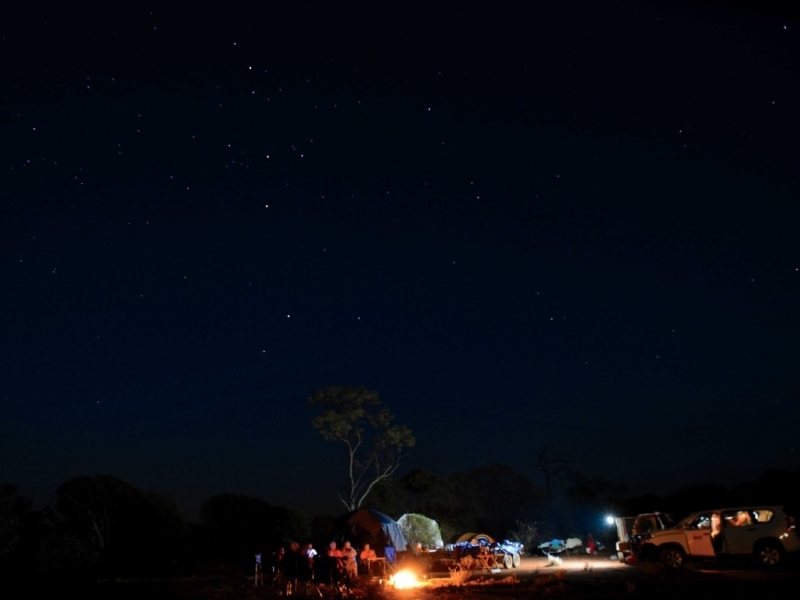World of Wander
<div>Last year, Kris Dreessen, <em>SMC ’93</em>, left her job, got rid of her possessions and embarked on a tour to document the work and languages of the world’s everyday people.</div>
Photography By:
Kris Dreessen, SMC '93
Story by:
Kris Dreessen, SMC '93

The Southern Cross constellation twinkles above members of the Tjupan mob—the last fluent speakers of their Aboriginal language—during a camping trip to their sacred land.
Now age 77, Brian Champion has lived in two worlds. As a young boy, he lived with his parents and other Aboriginal Kaprun people in Western Australia. When he was about 7 or 8 years old, Champion was taken under Australian government order to a mission hundreds of miles away, where he was trained to be a farmhand and prohibited from speaking Kaalamaya, his native language. For nearly 60 years, until the late 1960s, thousands of Aboriginal children were taken to Christian missions to assimilate to a white world. They were called the “stolen generation.”
Brian eventually ran away and reunited with his parents. As an adult, he retaught himself Kaalamaya, to regain his identity.
Last fall, I spent five weeks with Champion, who is the last fluent speaker of Kaalamaya. He has dedicated years to preserving the ancient Aboriginal language by teaching it
to others and recording his people’s history. But soon, all his knowledge and memories will be lost—Champion has Alzheimer’s disease. He hopes I will share his and the Kaprun story.
“We want the world to know we are here,” he says.
ON THE ROAD
In April 2014, I took leave from my job as a magazine editor, sold or gave away most of my possessions, and said farewell to family and friends to travel around the world to live my dream: to share stories of everyday people who are making differences in the lives of others and in their communities, and to help document and preserve endangered languages. In order to identify villages that might want my help, I contacted researchers and linguists and told them what I wanted to do, and they connected me with communities that wanted to be documented.
My adventure began in Nicaragua, where I lived with farmers in the mountain community of Las Minitas. For six years before this trip, I’d helped them with coffee, basketmaking and ecotourism initiatives, and am making a long-term photodocumentary about their lives. One of their dreams was to open a preschool, so I raised $5,300 through friends for materials. Then the farmers and I stacked bricks, laid cement and built it from the ground up.
In the remote Kenyan countryside, linguists are undertaking a comprehensive study of four Luyia languages and creating dictionaries. I lived with a Tiriki family and created an intimate portrait of each community that reflects its members’ values, everyday lives, changing customs and traditional practices still in use. In Bukusu culture, circumcision is a sacred event: It is the rite by which a boy becomes a man. Few outsiders have seen the ritual, but one family invited our team to dance, chant and celebrate with them. We photographed the 16-hour event to preserve the tradition.
In the Australian Outback, three Aboriginal groups—including Brian Champion’s—are working with a linguist to create the first written dictionaries and grammar analyses of their languages. Until now, they were passed orally. The groups I met are the final speakers of their languages.
I was with the linguist and the Aboriginal members when they visited their ancestral land. For some elders, it was likely the last time they would be there. I also helped create a visual story of development in the region, for the first time with focus on impact on the Aboriginals’ land and rights.
No matter where I was—in cities or remote towns, over five continents—people’s lives have inspired me.
On a small farm, Hardley and Lydia had enough for themselves, so they took in a boy who had no one.
On the Kenyan plains, Maasai warrior Sunde protects the lions he once hunted.
Determined not to let the Ngalia language die, Kado started the first school program in Western Australia to teach an Aboriginal language.
I felt connected to people all over the world. We learned about and from each other and shared meals. When we couldn’t communicate verbally, we used gestures and miming. In the photographs I took, I tried to document not only their differing cultures and perspectives, but the friendships and understanding we created together.